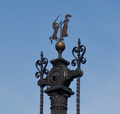|
New Town, Warsaw
New Town,[a] historically known as New Warsaw,[b][1] is a neighbourhood, and an area of the City Information System, in the city of Warsaw, Poland, located within the district of Śródmieście. The town of New Warsaw had been established in the early 15th century, being located to the north from Old Warsaw. In 1791, it had been incorporated into the city of Warsaw. HistoryThe historic district of the New Town was formed at the turn of the 14th century as an independent city.[2] The official recognition of the New Town occurred in 1408, when it was separated from the Old Town by an act issued by Janusz I the Old, Duke of Masovia.[3] At that time the new city encompassed the territory of the New Town Market Square and streets - Freta, Kościelna, Koźla, Przyrynek, Stara and Zakroczymska. It was independent from the Old Town authorities and had its own vogt, council and a town hall. In 1411 the Parish Church of St. Mary was erected, and according to the 1546 mensuration there were 204 estates in the Warsaw New Town. The largest investment of that time was the Sigismund Augustus bridge built between 1568-1573 by Erazm Cziotko (c. 500 m (1,600 ft) long).[4] Unfortunately it was destroyed in 1603 by the drifting ice floes.  The disastrous time of the Swedish-Brandenburgian invasion (1655–1660), left the predominantly timber buildings of the New Town burned, but because of those events many beautiful and more permanent buildings were erected (the Town Hall, built in 1680; St. Kazimierz Church, 1688–1692; the Kotowski Palace, 1682–1684; the Holy Spirit Church, 1707–1717; and the ornate chapel of the Kotowski family, constructed between 1691-1694) by the most prominent Warsaw architects (especially Tylman Gamerski).[3] After 1791, due to the tenets of the Constitution of May 3, 1791, the New Town was incorporated into the city of Warsaw. That is why the Town Hall was pulled down in 1818. During the Warsaw Uprising (1 August – 2 October 1944) the New Town was completely destroyed due to the extensive bombardment of the insurgent positions by the Germans.[3][5] Many historic edifices, that served as hospitals and shelters for the inhabitants were razed to the ground.[3][5] The reconstruction of the New Town begun in 1954. However, some of the significant buildings were not restored by the Communist authorities (e.g., Kotowski Palace).[6] Symbols As a separate territorial entity, the New Town was using its own seal with a coat of arms. A version known from 1648 features a female figure and a unicorn standing on its back feet. It can be found in the Central Archive of Historical Records. The inscription in the rim is in Latin: "SIGILLUM * NOVA * CIVITATIS * VARSCHOVIENSIS".[7][8] In the Middle Ages, the image of a virgin with a unicorn on her knees was a frequent motif of Christian art as a symbol of the Blessed Virgin Mary, and the unicorn itself symbolized Christ. After the incorporation of the New Town into Warsaw, the Warsaw Mermaid began to be used as the coat of arms. The image of a girl with a unicorn can still be found in the main square, it decorates the top of the well in front of the St. Kazimierz Church. An eclectic cast-iron well from the second half of the nineteenth century set up there around 1957.[9] GalleryHistorical images
Churches
Others
See alsoWikimedia Commons has media related to New Town in Warsaw. NotesReferences
External linksWikivoyage has a travel guide for Warsaw - Old & New Town. Wikimedia Commons has media related to New Town in Warsaw. |
||||||||||||||||||||||||





![St. Mary's Church, 1411[10]](http://upload.wikimedia.org/wikipedia/commons/thumb/1/15/Ko%C5%9Bci%C3%B3%C5%82_Nawiedzenia_Naj%C5%9Bwi%C4%99tszej_Marii_Panny_-_02.jpg/120px-Ko%C5%9Bci%C3%B3%C5%82_Nawiedzenia_Naj%C5%9Bwi%C4%99tszej_Marii_Panny_-_02.jpg)
![St. Hyacinth's Church, 1603-1639[10]](http://upload.wikimedia.org/wikipedia/commons/thumb/1/1c/Ko%C5%9Bci%C3%B3%C5%82_%C5%9Bw._Jacka_w_Warszawie_2020.jpg/120px-Ko%C5%9Bci%C3%B3%C5%82_%C5%9Bw._Jacka_w_Warszawie_2020.jpg)
![St. Benno Church, 1669[10]](http://upload.wikimedia.org/wikipedia/commons/thumb/d/d4/Ko%C5%9Bci%C3%B3l_%C5%9Awi%C4%99tego_Benona_w_Warszawie.jpg/90px-Ko%C5%9Bci%C3%B3l_%C5%9Awi%C4%99tego_Benona_w_Warszawie.jpg)
![St. Kazimierz Church, 1688-1692[10]](http://upload.wikimedia.org/wikipedia/commons/thumb/4/48/Saint_Kazimierz_Church_in_Warsaw_-_New_Town.jpg/120px-Saint_Kazimierz_Church_in_Warsaw_-_New_Town.jpg)
![Holy Spirit Church, 1717[10]](http://upload.wikimedia.org/wikipedia/commons/thumb/9/96/Ko%C5%9Bci%C3%B3%C5%82_%C5%9Bw._Ducha_w_Warszawie.jpg/80px-Ko%C5%9Bci%C3%B3%C5%82_%C5%9Bw._Ducha_w_Warszawie.jpg)
![St. Francis Church, 1733[10]](http://upload.wikimedia.org/wikipedia/commons/thumb/7/7d/Ko%C5%9Bci%C3%B3%C5%82_%C5%9Bw._Franciszka_w_Warszawie_2021.jpg/120px-Ko%C5%9Bci%C3%B3%C5%82_%C5%9Bw._Franciszka_w_Warszawie_2021.jpg)






